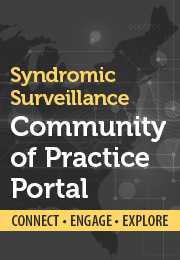- Improve representativeness of data:
- Identify, recruit, and onboard hospitals, Health Information Exchanges (HIEs), or aggregator services to the syndromic surveillance platform (SyS-P)
- Establish Data Use Agreements (DUAs) with (1) cloud environment owner (currently ASTHO) and (2) identified facilities according to jurisdictional law
- Improve data quality, timeliness and utility (i.e., complete, valid, reliable and useful):
- Register users for the SyS-P
- Conduct data quality assessments
- Use syndromic surveillance data and analytic tools for public health decision-making
- Collaborate with CDC on syndromic surveillance for health events of regional or national interest
- Strengthen syndromic surveillance practice:
- Maintain or establish jurisdictional working groups
- Participate in National Syndromic Surveillance Community of Practice (NSSCoP) activities and other professional development activities that further syndromic surveillance and practice
- Attend an annual NSSP grantee meeting at the CDC
|
- Improved geographic and population-based representativeness of syndromic surveillance data
- Improved syndromic surveillance data quality, i.e. data are complete, valid, and reliable
- Improved knowledge and ability of state and local health department staff in conducting syndromic surveillance
- Enhanced use of syndromic surveillance within state and local jurisdictions.
|
- Increased data sharing between/among jurisdictions for local/regional/national health events
- Timely identification of syndrome patterns for anticipated or present public health threats
|
- Improved synergy/integration of syndromic surveillance data with other surveillance systems within participating health departments
- High quality syndromic surveillance data for improved nation-wide all-hazard situational awareness for public health decision-making, enhanced responses to hazardous events, and outbreaks.
|




 ShareCompartir
ShareCompartir